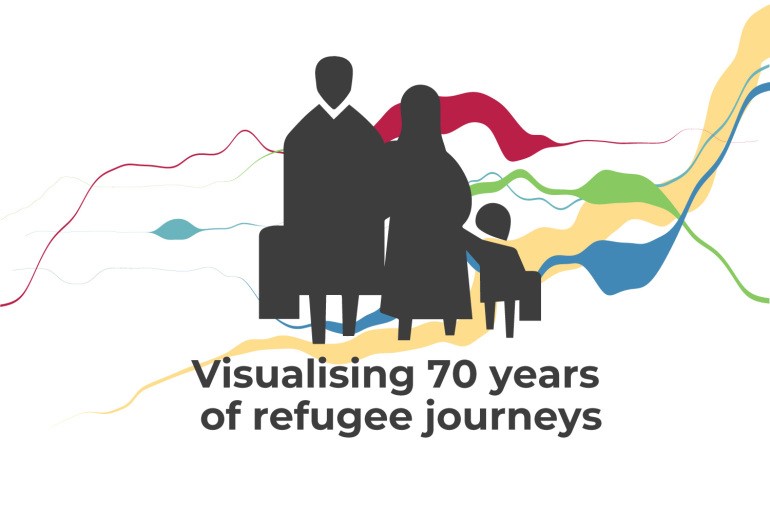
Thirty million of those are refugees, the rest are displaced within their own country (48 million) or asylum-seekers (4.1 million), according to UNHCR’s latest report. Nearly half of these forcibly displaced people are children.
55 percent of refugees come from three countries: Syria, Palestine and Venezuela.
During the COVID-19 pandemic, “everything else has stopped, including the economies, but wars and conflict and violence and discrimination and persecution, all the factors that pushed these people to flee, have continued,” UNHCR chief Filippo Grandi said.
Refugee journeys during 2020
In 2020, 1.27 million people from 64 countries became refugees. The infographic below shows the desperate journeys these people took despite the additional challenges brought on by COVID-19.
Africa accounts for more than one-third of the world’s displaced people. By the end of 2020, at least 30.6 million people were displaced across the continent.
In 2020, nearly 60,000 refugees fled from Ethiopia to neighbouring countries following violence in several parts of the East African country. In November 2020, fighting broke out in Ethiopia’s northern Tigray region displacing more than one million people according to the International Organization for Migration.
In the Middle East, Syrian refugees continued to flee their country’s 10-year-long war, with nearly 134,000 recorded to have left in 2020. Half of them (65,000) fled to neighbouring Turkey, which now hosts the world’s largest refugee community – 3.7 million people. That same year, nearly a quarter of Syrian refugees (32,500) reached Germany.
In Latin America, nearly 400,000 refugees fled Venezuela following a political and economic crisis in the country. Of these, 139,000 were recorded fleeing to Peru, 80,000 to the Dominican Republic and 60,000 to Brazil.
In Asia, the UN recorded at least 29,000 refugees from Myanmar. Nearly all of these refugees arrived in neighbouring India (17,000) and Bangladesh (12,000).
In Europe, at least 89,000 refugees fled from Azerbaijan to Armenia following 44 days of fighting that broke out between Armenian and Azerbaijani forces in the disputed territory of Nagorno-Karabakh.
Across the Atlantic, during 2020, the United States received 8,500 refugees from 20 countries. Nearly half of these refugees came from only three countries: Venezuela (1,600), El Salvador (1,200), and Guatemala (1,100). This is significantly lower than in 2019 when the country received 32,000 refugees.
Canada received 7,500 refugees from 21 countries in 2020. The top countries of origin were Nigeria (1,400), Iran (1,200) and Hungary (629). On the other side of the globe, Australia received only 956 refugees in 2020 – mostly from Iran.
Where are the largest refugee camps?
Refugee camps are intended as temporary safe haven to meet refugees’ basic needs. However, many people end up living in these camps for decades. According to the United Nations High Commissioner for Refugees (UNHCR) in Kenya: “Many displaced persons spend more than 16 years living as refugees in temporary shelter.”
The infographic below highlights some of the largest refugee camps around the world.


The Kutupalong camp in Cox’s Bazar, Bangladesh, is the world’s largest refugee camp. It was set up informally in the early 1990s after Myanmar’s minority Rohingya began to flee several crackdowns on them in Rakhine state.
In 2017, brutal crackdowns tore through the state and the camp had to be significantly expanded, reaching a capacity of approximately 800,000 people.
On March 22, 2021, a huge fire engulfed a neighbouring refugee camp in Cox’s Bazar. Fifteen people were killed and tens of thousands were left without their homes and belongings.

The Dadaab refugee complex in Kenya comprises three large refugee camps – Hagadera, Dagahaley and Ifo – and houses more than 200,000 refugees near the border with Somalia. Dadaab was established in 1991 following the civil war in Somalia and expanded in 2011 following widespread drought and famine.
The Kakuma refugee camp in northwest Kenya is home to at least 150,000 refugees mostly from South Sudan and Somalia. The camp was established in 1992 following the arrival of thousands of Sudanese children who were fleeing the civil war.
In March 2021, Kenya’s government announced that it would close the Dadaab and Kakuma refugee camps by June 30, 2022.

The Zaatari refugee camp was established in Jordan in 2012 to house Syrian refugees. Today, it is the largest Syrian refugee camp in the world. The world’s first COVID-19 vaccination centre in a refugee camp opened there in February 2021.
70 years of refugee journeys
In 1951, the UN established the 1951 Refugee Convention, set up to protect the rights of refugees in Europe in the aftermath of World War II. In 1967, the convention was expanded to address displacement across the rest of the world.
The infographic below highlights 70 years of refugee journeys, from 1951 to 2020. The number of refugees has more than doubled over the past decade from 15 million in 2011 to 30 million in 2020.

The plight of Palestinian refugees is the longest unresolved refugee problem in the world. On May 14, 1948, the British Mandate for Palestine expired, triggering the first Arab-Israeli war. Zionist militias expelled at least 750,000 Palestinians. According to figures compiled by UNHCR, by 1952 the number of Palestinian refugees was 867,000. Today, that figure is 5.7 million.
Afghanistan has been ravaged by four decades of war. From 1979 to 1989, the country was a stage for one of the Cold War’s last battles as Soviet troops fought a bloody guerrilla war against the Afghan mujahideen. For the next decade, the county struggled on. Just 12 years after the Soviet withdrawal, Afghanistan would find itself invaded again, this time by the US. The highest number of Afghan refugees was recorded in 1990 where 6.3 million refugees were reported.
Which countries host the most refugees today?
At 6.7 million people, Syrians are the biggest population of refugees today followed by Palestinians (5.7 million) and Venezuelans (4 million). As of 2020, 88 percent of the world’s refugees originated from only 12 countries.
On the receiving end, 65 percent of the world’s refugees are hosted by only 16 countries. Turkey hosts the most refugees (3.7 million) followed by Jordan (3 million) and Colombia (1.7 million).
In Europe, Germany is home to about 1.2 million refugees, the highest in the continent.
According to UNHCR, developing countries host 86 percent of the world’s refugees.

On World Refugee Day, Al Jazeera looks at the painful journeys refugees were forced to take in 2020 despite the global pandemic.
SOURCE: AL JAZEERA.
- Most Viewed
- Most Popular
















